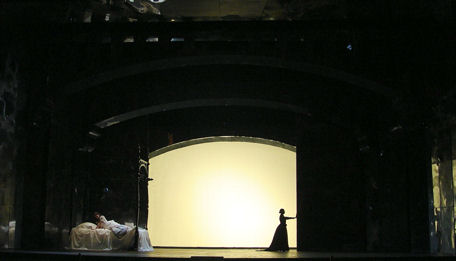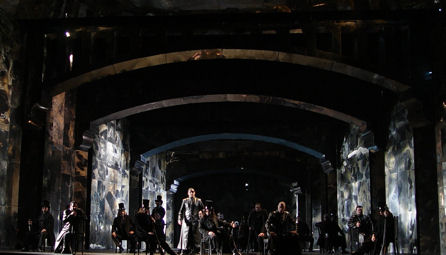Other Links
<Editorial Board
- Editor - Bill Kenny
- London Editor-Melanie Eskenazi
- Founder - Len Mullenger
Google Site Search
SEEN
AND HEARD INTERNATIONAL OPERA REVIEW
Donizetti, Lucia di
Lammermoor:
Soloists, Orquesta Sinfónica del Principado de Asturias. Coro Opera
de Oviedo.Conductor: Roberto Rizzi Brignoli. Teatro Campoamor de
Oviedo.15.11.2007 (JMI)
Production from
Teatro Municipal de Santiago de Chile.
Director: Emilio Sagi.
Sets: Enrique Bardolini.
Costumes: Imme Möller.
Lighting: Eduardo Bravo.
Cast:
Lucia:
Desirée Rancatore.
Edgardo: José Bros.
Enrico: Dalibor Jenis.
Raimondo: Felipe Bou.
Arturo: Jon Plazaola.
Mikeldi Atxalandabaso:
Normanno.
The biggest problem of this production however was in the pit, in
performance that was actually lamentable. Roberto Rizzi Brignoli's
only asset was offering the most complete version possible,
including the dialogue between Raimondo and Normanno at the end of
the Mad Scene (a true anticlimax, by the way) and repeats of the
cabalettas. For the rest, the question was whether rehearsals were
useful at all: hurried tempi, a uniformly forte sound and serious
problems of balance between stage and pit were all too obvious. And
if this wasn't bad enough I should add that the performance Mr
Brignoli drew from his orchestra was approximately worthy of a
music hall. This orchestra has shown real quality in the past, most
recently in Tristan und Isolde, but this time it was a very
poor shadow of itself. Conductor an opera is more that moving arms
about in demanding gymnastic exercises. What really counts are the
results and these were just too poor here to be acceptable. The
Opera of Oviedo chorus looks more and more like a proper opera
company choir these days though particularly the women. Thanks to
the courage of the people in charge of Opera Oviedo the chorus has
been dramatically improved and all their hard work has proved
worthwhile.
This introduction will explain my reaction to the performance of
Sicilian soprano Desirée Rancatore as Oviedo’s Lucia. She has always
been and continues to be a light soprano with outstanding
stratospheric notes, and it's not for nothing that her most famous
role is Olympia in The Tales of Hoffmann. This means though
that her capacity to astonish in Mad Scene is more than doubtful. It
is true that her voice has evolved and today she has a richer low
register than a few years ago, but her middle range still lacks
sufficient weight - particularly at passaggio zone - whereas the
high notes are still there, perhaps with a little less brilliance
than before. If Lucia must move the audience, Ms Rancatore did quite
get there and was cheered only after her duet with the flute. She
sang “Regnava nel silenzio” perfectly correctly and without much
brightness, was somewhat lacking in the duet with Enrico, but
delivered all the high notes in her great scene wonderfully, in a
quite traditional stage performance. If her middle voice does
acquires more weight, she could be a very good Lucia, we will have
to wait and see. A totally different matter of course, is that for
any Artistic Director, the high notes in Lucia are still a must,
since this is what the public expects.

The main interest from the rest of the cast was the presence of
the Catalan tenor José Bros as Edgardo. During the first part of
the performance it was clear that he was not at his best,
uncomfortable and rather insecure, especially with top notes, which
is certainly not usual for this artist. An announcement of his
indisposition due to tracheatis was made at the beginning of the
second half, which should have been done before the opera started.
Singing line, elegance and phrasing was always present despite this
problem however and I am sure that in the forthcoming performances
Mr Bros will deliver what we expect from him.
Czech baritone Dalibor Jenis was a standardised Enrico, without too
much vocal interest. He has a pleasant voice in the center, but sang
with few nuances and not very outstanding diction. Felipe Bou was a
bright Raimondo in all respects, a good choice of a young singer who
is clearly improving. Jon Plazaola showed his vocal quality yet
again as Arturo, and can be counted as a real luxury in secondary
parts nowadays. Mikeldi Atxalandabaso made a fine Normanno, both as
singer and actor.
Emilio Sagi's production of was premiered in Santiago de Chile two
years ago and certainly very adequate, without being exceptional.
The staging consists of a room with pseudo metallic walls crowned by
arches which help with voice projection, so important in opera. The
action and, therefore, the costumes are transferred to the end of
XIXth century and the mostly dark sets are helped by some literally
bright lighting by Eduardo Bravo.
Teatro Campoamor enjoyed its usual packed house and rated a
moderate success for Rancatore, Bros and Sagi at the final
curtain.
José M. Irurzun
Pictures © Opera de
Oviedo
